Rug Weaving and How Area Carpets Are Made
Search and shop our antique rugs online
Comprehensive Rug Making Guide:
Weaving Rugs and Carpets by Hand
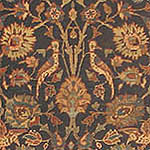 Hand made rugs have a certain built-in value that ranks them above machine-made products. Hand-made labor is more costly and carries with it a certain expectation of care and quality. Hand-made carpets involve an endless series of choices and decisions, minor twists and turns, that collectively give the piece its personality and presence, something that the finest machine made carpet lacks.
Hand made rugs have a certain built-in value that ranks them above machine-made products. Hand-made labor is more costly and carries with it a certain expectation of care and quality. Hand-made carpets involve an endless series of choices and decisions, minor twists and turns, that collectively give the piece its personality and presence, something that the finest machine made carpet lacks.
More about Hand Made Carpets
Machine Woven Rugs and Carpets
 Machine made carpets and rugs – since the advent of western industrialization in the nineteenth century, rugs have been manufactured by machine loom processes of various types. Such carpets are generally made from the same rug materials – wool, silk, and cotton, often of high quality. The the standards of fabrication may also be high, and consistently so. But machine made rugs are mechanical in their execution, and often in their design as well.
Machine made carpets and rugs – since the advent of western industrialization in the nineteenth century, rugs have been manufactured by machine loom processes of various types. Such carpets are generally made from the same rug materials – wool, silk, and cotton, often of high quality. The the standards of fabrication may also be high, and consistently so. But machine made rugs are mechanical in their execution, and often in their design as well.
More about Machine-Made Rugs
Materials Used When Weaving Rugs and Carpets
The materials that go into a weaving rugs are as important as the design and workmanship. They contribute enormously to the overall impression of the rug – its color, texture, tactile feel, and above all its durability. Wool, Cotton, Silk, Dyes, Camel Hair, Bamboo Silk, Banana Silk, Viscose Rugs
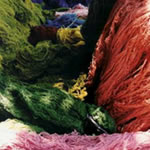
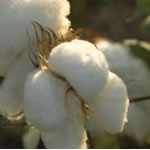


Wool Cotton Silk Dyes
You can Also View Our Current Collection Of Rugs The Were Woven Using:
Silk and Wool Rugs, Silk and Metallic Rugs
How Rugs are Made – Materials Used to Weave Rugs
The processes and the materials that go into the construction of a quality rug have been largely unchanged for a very long time. While various cultures across the globe have each developed important rug making traditions, from cultures as far afield as the Turkish and the Chinese, there is in fact very little variety in how rugs are actually put together.
Similarly, there is very little variety in the type of materials that are utilized in the construction of a rug or carpet. It is important to note that the materials that go into a rug are certainly as important as the design and workmanship that go into it… even with the most talented of weavers would have a difficult time putting together a quality piece if they had only sub-par materials to work with.
When everything is said and dome, the materials used to weave rugs contribute s enormously to the overall impression of the rug – its color, texture, tactile feel, and above all its durability.
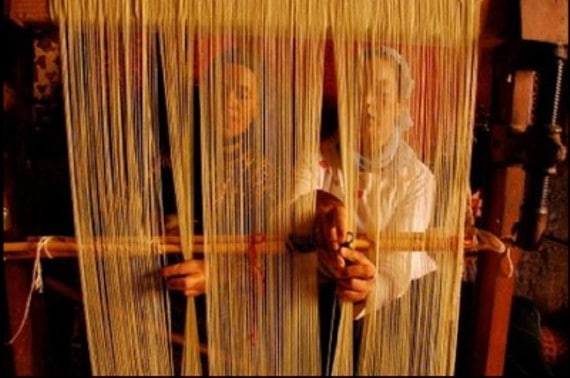
Materials Used to Weave Rugs
Of the materials that are typically used to construct a rug, certainly the most prevalent are wool, cotton, silk, and the various dyes that are employed to get the colors of the piece just right.
Silk rugs differ in appearance quite substantially from rugs that are made with cotton or wool — silk rugs possess a charming sheen and often possess highly detailed patterning throughout. The relative fineness of silk to materials like wool and cotton allows weavers to create very precise patterns and motifs.
Meanwhile, the dyes that are used to color a rug may be either chemical or vegetable; that is, either synthetic or natural. Natural dyes were the only type available for centuries, and have a distinct way of aging. This is one clear, tangible example of how the materials used to make rugs have a tremendous impact on the overall look and feel of the finished piece.
Techniques & Construction of Rug Weaving and Woven Carpets
Perhaps the most important way to identify the quality of a rug is not through its design, but through the materials and technique used to weave the rug. Even the slightest differences in these aspects of a rug’s make can have a tremendous impact on the rug’s durability and overall value. Someone trained in assessing these characteristics can also come to several conclusions about the rug beyond its quality, such as its place of origin and the age of a particular piece.
Shearing, Carding, Spinning, Loom, Foundation, Warp, Wefts, Shed Stick, Heddle
Different Carpet And Rug Weaves
Kilim Rug Weaving | Soumak Rug Weaving | Knotted and Pile Rugs | Hand Tufted Rugs
Types of Knots Used in Pile Woven Rugs & Carpets
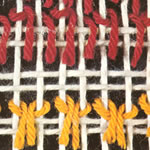 The “knots” of a pile rug are a bit of a misnomer. Rather than being like knots in the traditional sense, these knots are really more like loops. Each knot is looped around a pair of adjacent warps. In a pile rug, the knots consist of a “knot collar”, which wraps around the warps and the ends, which are referred to as the “pile”. These knots can be woven through several different configurations, which lend themselves to the diversity of design found in pile rugs.
The “knots” of a pile rug are a bit of a misnomer. Rather than being like knots in the traditional sense, these knots are really more like loops. Each knot is looped around a pair of adjacent warps. In a pile rug, the knots consist of a “knot collar”, which wraps around the warps and the ends, which are referred to as the “pile”. These knots can be woven through several different configurations, which lend themselves to the diversity of design found in pile rugs.
More about Types of Knots Used in Pile Rugs & Carpets
Weaving Rugs and Carpet Designs
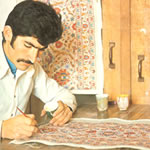 What first catches the eye about a rug is not likely to be the technique used in making it or the quality of its materials, but rather its design. The scope of rug design is so wide that encompassing it is nearly impossible. From highly detailed and complex designs to more stylized and modern looks, it’s clear that a rug’s design is only as limited as its weaver’s imagination.
What first catches the eye about a rug is not likely to be the technique used in making it or the quality of its materials, but rather its design. The scope of rug design is so wide that encompassing it is nearly impossible. From highly detailed and complex designs to more stylized and modern looks, it’s clear that a rug’s design is only as limited as its weaver’s imagination.
More about Designs of Rugs & Carpets
Guide to Antique Rug Making
Welcome to the antique rug making world
Rug Making – Authentic antique hand-made rugs and carpets represent a unique and centuries old craft. With living archaeological specimens such as the Pazyryk carpet dating back more than 2,500 years, we know that people have been weaving fine rugs and carpets for a very long time.
Remarkably, over the centuries (and even millennia), there are a great many facets of fine rug construction that have changed only very little.
For instance, weaving on a loom with wool from local sheep is a practice as old as human civilization itself.
While there have certainly been numerous innovations in regards to the manufacture of fine rugs and carpets over time, including the development of machine-making, there remain certain pockets, especially Morocco, Turkey and Persia, where rugs are made more or less the same way that they have always been made.
The best antique rugs and carpets are always those that were made by hand, and with all natural ingredients. Indeed, there is something very special and unique about hand-made rugs, in that the people who weave them, the sheep who give the wool, and the vegetables and plants that yield the dyes, all live harmoniously together.
This tight-knit relationship between the producers of fine rugs and carpets and their environment is part of what makes such pieces so special.
How Rugs are Made: Traditional Hand-Knotted Rugs and Carpets
Rugs and carpets have been made for many centuries. The first rugs were made by tribal shepherds who needed heavy clothes to shield themselves from the cold and wind, who soon started to use them as floor coverings. Over the centuries, rug makers developed techniques to weave amazingly beautiful patterns and turned rug making into a form of fine art. Today, rugs are made by both hand and machine. However, much of the process has remained the same.

Rug Making
Here is a step-by-step description of rug making from the moment unprocessed wool is attained:
1. Wool is turned into yarn:
Wool is the most popular material for making rugs. It is strong, soft, long lasting and beautiful. Once unprocessed wool arrives at a rug making workshop, it is separated by hand to break up the clumps and remove any foreign materials that may have got stuck in it. Then it is fed into a machine that pulls it into individual strands. The stands are then spun into yarn. In previous centuries, wool was spun by hand on rudimentary spinning wheels.
2. The yarn is washed:
The yarn is then washed to remove the dust and grease thoroughly. The process involves submerging it in a detergent bath, wringing it out several times, and then washing it with clean water to remove the detergents. The washed yarn is dried in the sun for two to three days.
3. The yarn is dyed:
The washed yarn is hung onto a rack and submerged in a dye, which is created by using a combination of natural or synthetic elements to produce the desired hue. To allow the dye to work its way into the yarn, it is heated to a near-boiling temperature for a specific period of time. The longer the time, the darker the hue. The dyed yarn is then put out in the sun to dry.

Yarn Drying
4. How a carpet is woven:
Once the yarn is dry, it is ready to be woven into a carpet. There are primarily three ways to weave a carpet: knotting, tufting and hooking.
• Knotting: First, an artist draws a design for the rug on a special graph paper. A frame is then prepared by stretching columns of thread, called warps, vertically down the loom. Warps are usually made of cotton. The weaver then weaves the yarn knot-by-knot on the loom using a knotting method, such as Turkish knot, Persian knot and Tibetan knot.
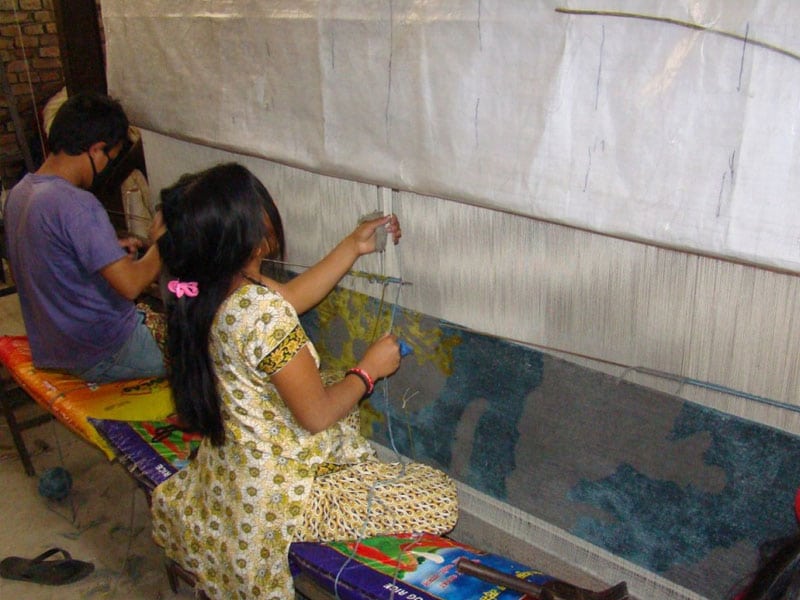
Rug Knotting
• Tufting: A pattern is drawn on a primary backing material using stencil. The backing material, usually made of cotton, is attached to a frame. The weaver inserts tufts of wool into the backing material using a tufting tool. The primary backing material is then covered with a latex material and a secondary backing material is attached. Then the surface loop pile is sheared to create a flat surface with dense pile.
• Hooking: Once the design, pattern and colors are chosen, usually from other carpets or pictures, the weavers weave the rug using a scaffolding system that allows them to raise and lower themselves along the entire length of the rug. They use a specialized tool to push the yarn back and forth through a cotton backing. This is the easiest and least expensive method of making rugs.
5. The rug is washed and dried:
The rug is once again washed thoroughly to remove dirt, detergent and yarn particles. The washing process involves laying the rug on a flat surface, pouring clean water over it, and using wood planks with sharpened edges to force the water through the rug.
Rug making is a time consuming and labor-intensive process. It often takes several weeks to several months to make high quality rugs. But for the makers and collectors, the resulting works of art are worth all the trouble.
Other Carpet Weaving Techniques
The rug weaving process begins with the preparation of the wool, cotton or silk fibers. In the case of wool, it must be washed after being shorn. Then it is ‘carded’ to untangle the fibers. Once they are processed, the wool fibers, like the fibers of cotton and silk, must be twisted or ‘spun’ into longer lengths of ‘yarn.’ They may be ‘Z-spun,’ twisted clockwise, or ‘S-spun,’ twisted counter-clockwise.
Two or more spun yarns may then be ‘plied’ into thicker, more substantial yarns by spinning them in a direction opposite to that of the component yarns.

Z-spun and S-spun Wool Diagram
Whether they are pile or flat woven rugs are produced on looms like all other textiles. A rug loom is essentially a framework that enables the yarns making up the rug to be arranged horizontally and vertically under tension. Looms may be of either horizontal or upright vertical type.
Horizontal looms, which are favored by nomadic weavers, are arranged parallel to the ground some six to twelve inches above it, often outdoors. Upright vertical looms must be set up permanently indoors in a home or workshop.

Rug Loom For Weaving Carpets
The production of tapestry or flat woven kilim rugs begins with the placement of the plied yarns or ‘warps’ vertically on the loom in closely set parallel rows. Once these are in place the weaver then inserts un-plied yarns horizontally through the warps in an over-under fashion. Whether vertical or horizontal, more elaborate looms utilize a ‘shed’ apparatus that maintains space between alternate warps in order to pass the wefts through more quickly with the aid of a ‘shed stick.’
The design is achieved by introducing weft yarns of different color through the warps. Once the wefts are in place the weaver compresses them vertically with the aid of a weaver’s comb until they entirely conceal the warps, producing a ‘weft-faced’ tapestry.

Shed Stick
Pile or ‘knotted’ carpets are an elaboration of this process. The warps are set up in the same fashion along with a few initial rows of wefts. Then the rug weaver inserts a horizontal row of knots,’ actually only loops, made of un-plied yarns wrapped around successive pairs of warps with the yarn ends left hanging long.
These knots may be either symmetrical or asymmetrical. For symmetrical knots the yarns are inserted between two adjacent warps and then wrapped around them both so that both yarn ends come up together between both warps. For asymmetrical knots the yarn is inserted and wrapped around only one warp to pass under the next warp before emerging.

Symmetrical and Asymmetrical Rug Knots
Asymmetrical knots may be ‘open left’ or ‘open right’ depending on whether the weaver works from right to left or vice versa. Here too the design is achieved by inserting knots of different colors. Once the entire horizontal row of knots is complete, the weaver inserts one or more passes of wefts to secure the knots and the process is repeated.
Periodically the weaver will use a comb and sometimes a mallet to compress the knotting and wefts vertically. Collectively the warps and wefts comprise the ‘rug foundation’ while the trailing ends of the knots comprise the ‘pile.’
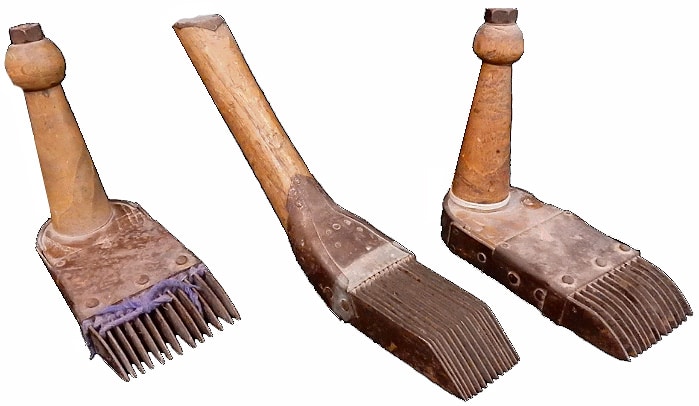
Image of Three Antique Rug Weaving Combs
During the weaving process, the ends of the knot yarns are left long and shaggy so that they do not come undone. After the weaving is complete the shaggy ends of the knot yarns are then cut or ‘clipped’ to a uniform length to produce the surface of the pile. The fineness of the weave depends on several factors – the relative thickness or thinness of the component yarns, how closely the weaver sets the adjacent warps, and how much the wefts and knotting is compressed vertically.
The finer the weave, the greater the number of knots per square inch, which is the product of the average vertical and horizontal knot count within a square inch.
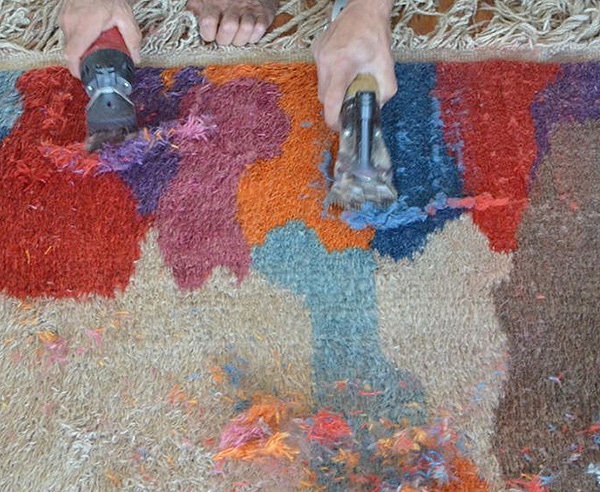
Shearing Hand Woven Rugs by Hand
Finer weaves, as opposed to finer woven rugs, would be between one and two hundred knots per square inch or more; a coarser weave would be less than one hundred. On more finely knotted rugs the pile tends to clipped relatively short to maintain the clarity and crispness of the more detailed, delicate rug designs and patterns. More coarsely woven rugs tend to have bolder, less intricate designs that in turn allow the pile to be left longer or shaggier. Coarser ‘high pile’ rugs of this kind also tend to have broader bands of multiple wefts separating the rows of knots giving the rug a more flexible, supple handle. More finely and densely woven rugs tend to have a firmer handle that makes them lie flat.

Coarse Carpet Weave Vs Finely Woven Rug
Rugs known as ‘soumaks’ represent intermediary technique between tapestry kilim and knotted pile. In rugs of this kind the process also begins with the placement of the warps on the loom and the initial insertion of wefts.
But instead of introducing yarns of various colors in knotted loops with cut shaggy ends to produce the rug design, the yarns are looped continuously over the warps in various configurations, placing the yarns largely above the level of the warps with a cabled-texture more like pile. Soumaks are therefore thicker and more substantial than tapestry kilims.

Antique Soumak Rug Weave
Whether in flat woven or knotted pile technique, the sides and ends of the rug are given a special finish to bind and reinforce the weaving. The sides are strengthened with coiled woolen binding added after the weaving process or sometimes made as part of the wefts. Once removed from the loom the long warp ends may be knotted or braided to prevent their unraveling.
Pile rugs will typically have narrow bands of kilim tapestry left at either end as protective reinforcement in addition to the knotting or braiding of the warps. Nomadic rugs, with pile weaving, often extend and embroider these kilim ends as ‘skirts’, sometimes up to a foot in length, to decorate and protect the ends of the carpet.

Rug Skirt and Rug Side Binding
Rug Making Techniques and Construction of Rugs
The construction and weaving of fine rugs and carpets is a centuries old craft. As such, there are a number of long-established methods for weaving rugs. In addition to the varied actual and physical rug weaving processes the commonly accepted materials do vary as well (the materials used for weaving rugs will affect the actual technique used and approach to the act of rug weaving) . While each artisan will weave a carpet with his or her own unique flair, there are certain things that are always the same.

Rug Weaving Techniques
The processing of the raw materials that are used in antique rug weaving and the general way that the rugs are woven each have an enormous effect on the ultimate overall quality, durability and value that each piece will exhibit. One needs to appreciate these issues to evaluate its worth. Some knowledge of the weaving technique is also indispensable in identifying carpet types as well as the age of a piece.
Such ‘structural’ considerations are far more instructive than the design in assessing the origin and quality of rugs.
This rug post about the different Persian carpet weaving regions and centers was published by Nazmiyal Antique Rugs in New York City.
